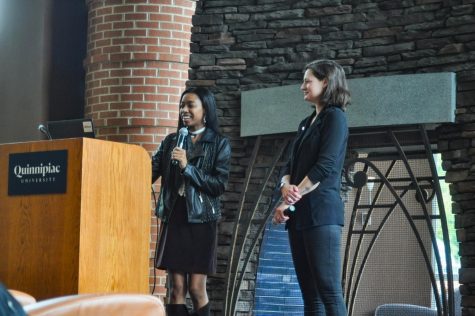As a part of its recognition of the accomplishments, struggles and stories of the LGBTQ community, the Quinnipiac University Office of Cultural & Global Engagement held the second annual LGBTQIA+ History Month Teach-In on Oct. 13.
The program hosted in the Carl Hansen Student Center Piazza included a lineup of student and faculty speakers. It opened with a presentation about LGBTQ representation in media by William Jellison, a professor of psychology and women’s and gender studies.
Junior political science major Leea Cotter attended Jellison’s portion of the event.
“It offered a perspective I have not really considered before regarding LGBTQ+ representation in television and films,” Cotter wrote in a statement to the Chronicle following the event. “The speaker mentioned how Hollywood tends to use stereotypical characteristics that are harmful to the overall population.”

Junior political science major Emily Diaz then led a discussion about the intersections of Latinx and LGBTQ identities. Next, Arnold Bernhard Library Public Services Librarian Robert Young featured his work chronicling the history of gay men.
Young discovered photographs of a gay couple from the 1950s on eBay in 2010. Since then, he has been developing collections to track down family and friends, and sometimes, the people featured in the photographs themselves.
“I was born in the early sixties, so these men were from my mother and father’s generation, and they were also before the Stonewall Rebellions kind of sparked the modern LGBTQ movement, which I benefited from,” Young told the Chronicle.
Young said that LGBTQ people of the mid-20th century such as those in his photographs grew up in a very different world than he or LGBTQ youth today have.
“Whenever I share the photos on Facebook I get such a huge response from the gay men who said, ‘These are wonderful… I feel so moved when I see the photos, these mean so much to me, this is our history,’” Young said. “This is stuff that you don’t think of (being in) this time period of people living happy, fulfilled lives.”
Following Young’s presentation, Associate Athletic Director for Academic Support Kristen Casamento and Senior Associate Athletic Director for Business and Administration Alyssa Hyatt highlighted professional and college-level athletes from the LGBTQ community. This included U.S. women’s soccer player Megan Rapinoe and University of Pennsylvania swimmer Lia Thomas.
“Sports is such a microcosm of society that if we could share the stories of the LGBTQ community and activists within athletics, maybe it helps to spark that conversation outside of athletics, too,” Hyatt told the Chronicle.
Part-time political science professor Ellie Beargeon spoke next on the topic of the LGBTQ experience within the armed forces.
Her research, “Diverse Warriors: The Changing Experiences of LGBTQ Servicemembers,” includes Beargeon’s own story as a lesbian Iraq War veteran as well as the accounts of other LGBTQ military members.
Beargeon told the Chronicle that she decided to participate in the event to show the different layers of being LGBTQ in the military. She said it is both an institution which has historically silenced LGBTQ people with policies, such as Don’t Ask, Don’t Tell while simultaneously being the way in which many LGBTQ youth escape poverty and unsafe home lives.
“In the verbatim words of current service members, they’re like, ‘yeah, we know that we weren’t welcome (in the military) before,’” Beargeon told the Chronicle. “But now we’re building these wonderful, gay lives for ourselves.”
The question Beargeon posed throughout her talk at the teach-in was “does anyone belong in war?” In addition, she raised a question about the morality of current military recruiting tactics which she said target vulnerable young people.
“It’s easy to write about these things in the academic setting,” Beargeon told The Chronicle. “It’s another thing to face the very real reality that wars are happening right now, in Ukraine, and Russia and Syria, and so, even though nobody belongs to wars, there are folks who will make meaning of it.”
Next, journalism professor Margarita Díaz gave a presentation titled “Adiós to All That: Leaving Home to Find My Latina, Lesbian, Immigrant Self.” To close out the Teach-In, there was a discussion about asexuality and its definitions, hosted by professor of sociology and women’s and gender studies Lauren Sardi and junior theater and game design double major Amari O’Connor.
Sheralyn Burke, a junior health science studies major, attended the event with professor Joanna Gentsch’s human sexuality class.
“I was surprised by how many movies portrayed LGBTQ negatively and how little positive representation there is,” Burke wrote in a statement to the Chronicle following the event. “I was also very impacted by the viewing of many different photographs of gay men and how they lived in the 1940s.”








